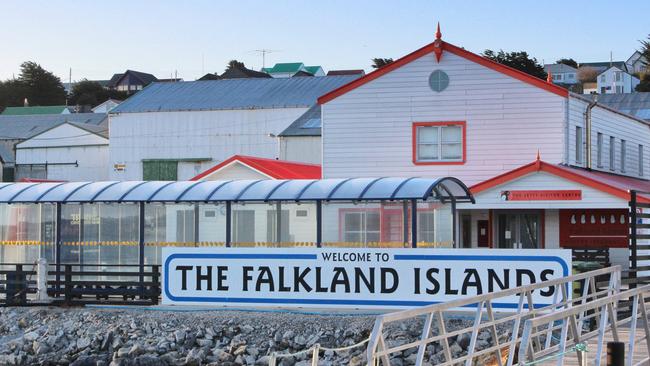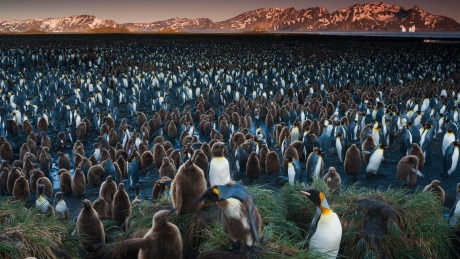Howling winds, rough seas and an outbreak of avian flu: defying the odds to reach the Falkland Islands
With its barren landscape and a sprinkling of very British sights (including a bust of Margaret Thatcher) the Falkland Islands are a unique travel destination – but first you’ve got to get there.

There’s nothing as effective as a doomsayer to dampen the anticipation of an exotic trip, except, perhaps, when multiple doomsayers are involved.
Informed or not, there are plenty of them confidently speaking up in the days before we’re due at Stanley, the tiny capital of the isolated Falkland Islands. A speck at the end of the world, it’s a place I’ve imagined seeing since 1982’s 10-week war between Argentina and the UK, but never figured I would.
With its barren landscape teeming with wildlife, and a sprinkling of quintessentially British paraphernalia (red phone boxes and terrace houses), this is a unique place – and well worth a visit, I’m told by people who’ve been there. And in the weeks leading up to our brief stay – a day’s long stop on a cruise around the bottom of South America – this is the destination with the greatest allure. Until the chorus of pessimists begins.
Don’t assume you’ll be able to disembark, our cruise director warns in a port talk days out from our anticipated arrival, alluding to the rough conditions that often hamper those arriving by sea. Two out of three ships fail to stop, a fellow passenger insists, reciting a statistic that, we learn only later, is actually the other way around. An avian flu outbreak has just shut nearby South Georgia and the South Sandwich Islands to outsiders, a fellow Aussie laments when we meet in Patagonia’s Ushuaia, our last stop before Stanley – and the Falklands, he confidently predicts, will likely follow soon.

The morning of our expected arrival, the cautions continue. Strong winds are a feature in this very southern part of the world, our captain informs our 2000 travelling companions by loud speaker in the hours leading up to our scheduled stop, and there is still a chance we will not be able to anchor offshore as planned.
And then the winds comply and the weather, though freezing, is comparatively fine, and suddenly we are disembarking from our tender into the heart of Stanley’s tiny village, to a streetscape that indeed has a red phone box at one end and a statue of Margaret Thatcher, Britain’s prime minister during the 1980s war, at the other.
Minutes later, in the huddle of authorised guides waiting for customers at the town wharf, we meet Garry. Like most of the locals who have materialised to show tourists around, this is his side hustle; he’s a maintenance worker at the governor’s small home nearby. Today, though, he is on annual leave, and he is soon piling us into his family’s four-wheel-drive to see some of the island’s most famous residents.

Five of the world’s 17 species of penguins are found in the Falklands. Among the million that nest here each summer there are rockhoppers, magellanics and macaronis, as well as the world’s biggest population of gentoos. But it’s the islands’ largest species we are most keen to see.
There are thought to be 1500 breeding pairs of king penguins on the Falklands, and they are almost entirely concentrated at Volunteer Point, a four-hour round trip away. Garry, however, has other ideas. While many of our cruise companions are heading for the far eastern side of the island, where they will also be blasted with sleet, we are instead being driven to Yorke Bay, just 20 minutes away.
Visiting king penguins so close to town is still a newish opportunity – and seemingly not that well known. Yorke Bay’s stunning white beach was closed in 1982 and remained off limits for decades thanks to the thousands of unexploded landmines that were left after the 1982 war.
A British-funded program to de-mine the island began in 2009. At a ceremony in late 2020 the final mine was detonated at Yorke Bay (Garry proudly reveals that his then-three-year-old son won a competition to press the button) and after 40 years the islands were declared mine free.

While Yorke Bay’s penguin colonies mostly survived those long decades – the species seemingly not heavy enough to set off the landmines hidden in the local sand dunes – today they can also be observed, from a safe distance, by the humans who were kept away for so long.
This morning we have the beach and its penguins to ourselves. There are dozens of magellanics and a small colony of king penguins near the water line and around the surrounding dunes. Observing them in silence from a few metres away, on a beach that was off limits for so long, is glorious, and as amazing and awe-inspiring as the realisation of this once-unimaginable visit.

Checklist
Getting there: If you’re not dropping by on a scheduled cruise, the limited flight options include Latam’s weekly flight from Santiago via either Punta Arenas in Chile or Rio Gallegos in Argentina. Visitors to the islands need to book accommodation in advance. latam.com; falklandislands.com
Eat and stay: In this corner of the South Atlantic, two of the few but best examples of locally sourced products are lamb and Patagonian toothfish. If you’re lucky, both will be on the menu at the reasonably priced Groovy’s, a large space in the centre of Stanley that doubles as the local karaoke outpost, as well as hosting regular games nights. Around the corner, The Waterfront Boutique Hotel offers rooms with a view. Its popular cafe serves lunch, dinner and weekend brunch. If you’re there around Christmas, the house-made fruit mince pies are outstanding. facebook.com/GroovysRestobar; waterfronthotel.co.fk

